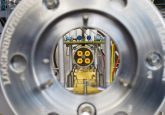1. What molecules do you predominantly work with, and (how/why) do you use HRMS for their analysis?

Bertrand Rochat: “During the last 15 years, I have performed quantitative and qualitative analyses of drugs, xenobiotics, endogenous metabolites and peptides. I use low-resolution mass spectrometers (MS) such as triple quadrupole (QQQ) and ion trap MS. Since 2012, I have tested new high-resolution mass spectrometry (HRMS) techniques and realized that, in addition to their first attribution (qualitative, discovery and identification analyses); they could perform excellent quantitative determinations. I spent a few years evaluating if HRMS (at least the ones I tested, Exactive and Q-Exactive MS) could be as efficient as QQQ-MS for quantification. My opinion was clear: HRMS was capable of performing analyses from targeted quantification to untargeted metabolomics [1]. Even if there are always some exceptions, the use of HRMS is a must. I believe that HRMS can be used for most, if not all LC–MS determinations whereas, in the future, low-resolution MS should (will) belong to some niche analyses. Importantly, I realize that HRMS will allow a step further in biomedical analysis because thousands of molecules can be recorded in a single run.”
Diego Cortes: “At PPD® Laboratories’ (VA, USA) bioanalytical lab, we have used HRMS to support bioanalysis of small molecule drugs and large molecule biotherapeutics, as well as biomarkers. We first began using HRMS for peptide mapping and protein characterization to support the development of methods using trypsin digestion and peptides as surrogate analytes for large molecule quantitation on conventional QQQ mass spectrometers. HRMS is still a great tool for providing protein/peptide sequence information and for selecting appropriate peptides used as surrogate analytes for quantitation or qualitative purposes.
HRMS has been used in quantitative bioanalysis approaches for a variety of small and large molecules, both digested and intact. More recently, we are applying HRMS to more complex multi-domain protein therapeutics, such as antibody-drug-conjugates, where we need to determine the drug-to-antibody ratio among some other high-level characterizations using proteomics techniques (e.g., top-down, middle-down, bottom-up). Protein therapeutics are also susceptible to post-translational modifications that can benefit from HMRS to be able to distinguish the native from the modified form. Examples of applications in this category include glycans qualitative/quantitative analysis and asparagine deamidation, both of potential concern in protein bioanalysis. With the resolution power of HRMS, the parent peptide containing asparagine can be selectively detected from the deamidation peptides without chromatographic resolution.
On the small molecule side, the resolving power of HRMS can overcome interference issues encountered with unit-resolution MS instruments and be a major advantage in quantifying certain problematic molecules. However, still in most cases, HRMS is being applied to facilitate method development or confirm the performance of an SRM assay, intended to be used for routine analysis on a QQQ instrument.”
Graeme Clark: “At Concept Life Sciences (Cambridge, UK) we work with everything from traditional ‘small molecules’ through to large proteins and antibody drug conjugates. We traditionally use HRMS for the traditional small molecule metabolite identification and structural elucidation studies, but we are witnessing a growth of HRMS in the support of absorption, distribution, metabolism and elimination/pharmacokinetic (ADME/PK) studies as this not only removes the need for upfront multiple reaction monitoring (MRM) optimization (needed in ADME screening triple quadrupole workflows), but also facilitates retrospective analysis for metabolites. Support of biotherapeutic modalities, such conjugated peptides and antibody drug conjugates as intact measurements, with high-resolution accurate mass (HRAM) are also becoming increasingly more common in understanding in vitro and in vivo metabolic profiles.”
Ian Edwards: “We work a great deal with large molecules using LC–MS. This has been driven by the increase in the development of peptide and protein therapeutics. In drug metabolism pharmacokinetic (DMPK) studies, analysts are concerned with the clearance of a drug after administration, and also how it is metabolized. Measuring the clearance of a peptide or protein requires quantification at multiple intervals postdose. The classical approach for large molecule quantification is by ligand binding assay because of its ease of use and throughput advantages. However reagent specificity and cross-reactivity are two concerns with this technology. LC–MS has emerged as a viable alternative or complementary technique because of its inherent specificity that results from direct mass measurement. Large proteins are typically analyzed following tryptic digestion using the surrogate peptide approach. Today, the gold standard for large molecule quantification by LC–MS is still tandem mass spectrometry using triple quadrupole mass spectrometers, where plasma samples are often analyzed in combination with immuno-affinity purification. However, the high mass resolution and accuracy afforded by HRMS can translate to higher sensitivity when selectivity is challenged by, for example, interference from endogenous species. An alternative to the surrogate peptide approach is the quantification of the whole molecule at the sub-unit or intact level, and these methods are being explored more and more. The benefit is the maintenance of molecular integrity, where HRMS, with its extended mass range, is ideally suited for intact mass detection and quantification of larger proteins such as monoclonal antibodies.”
Scott Summerfield: “Our group analyzes small and large molecules by means of LC–MS. Currently, the HRMS systems are used almost exclusively for large molecule bioanalysis while small molecule bioanalysis has focused on tandem quadrupoles. A number of factors have favored the continued utilization of low-resolution tandem MS for small molecule bioanalysis, but in my opinion, the most prevalent reasons have been (1) better overall instrument sensitivity and (2) availability of instrument time, because the proportion of HRMS instruments is low in most bioanalytical facilities (< 10%). With the most recent HRMS system we purchased, there are no real scientific barriers to prevent us moving small molecule work to this platform, other than we only have one and it’s busy doing protein work!
On the other hand, the selectivity of HRMS can be beneficial with peptides and proteins because the collisionally-activated dissociation process tends to produce complex MS/MS spectra with multiple competing fragmentation pathways. This was a fantastic benefit for the emergence of proteomics and MS-based protein sequencing, but reduces sensitivity for MS/MS-based quantitative bioanalysis.”
Timothy Garrett: “I work with endogenous small molecules for metabolomics. We perform global metabolomic studies to identify biomarkers of disease, treatment, or other biological factors. HRMS is essential in the identification of metabolites.”
[1] Rochat B. From targeted quantification to untargeted metabolomics: Why LC-high-resolution-MS will become a key instrument in clinical labs. Trends Analyt. Chem. 81 151–164 (2016).
1 2 >



